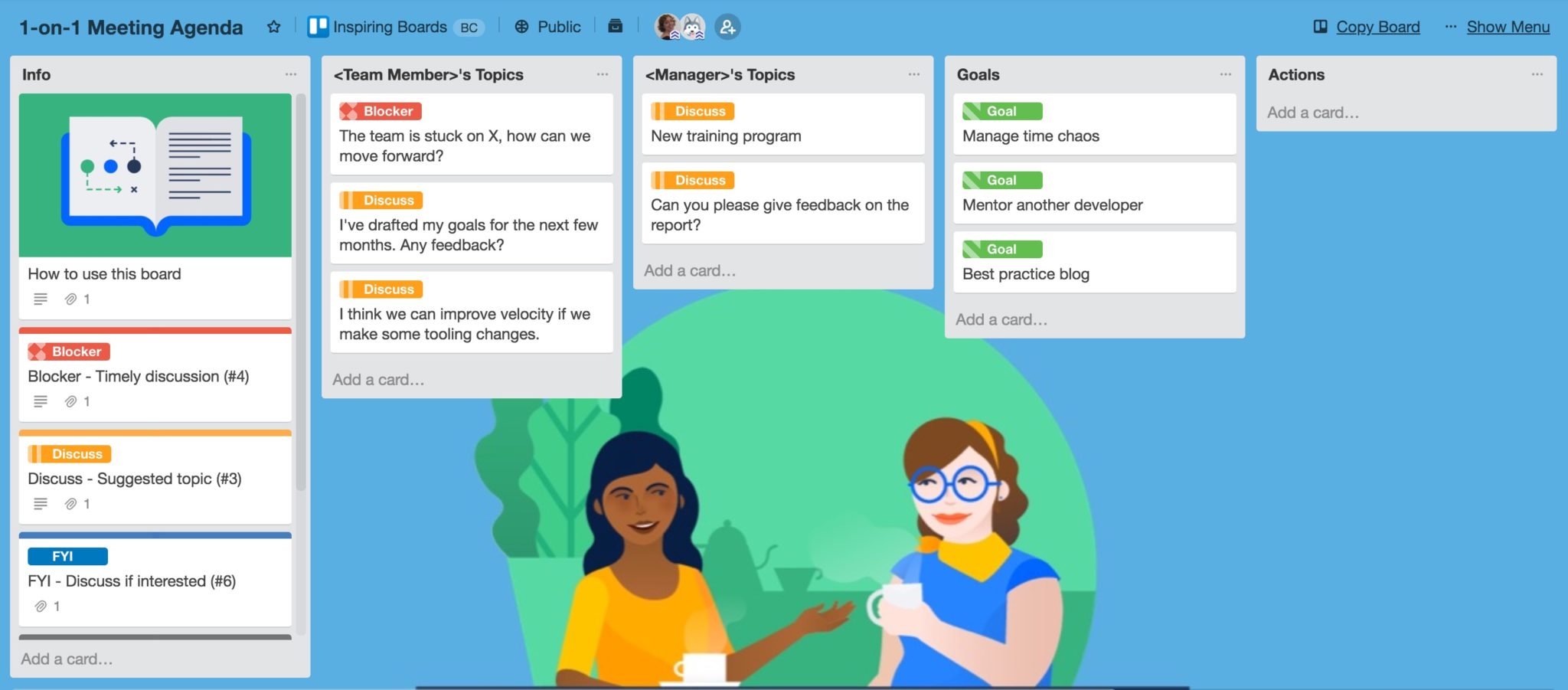As a manager or team lead, 1-on-1 meetings provide an opportunity to connect on a regular basis with the team. They help build strong rapport, which in turn increases effectiveness and understanding. As an individual contributor and member of the team, 1-on-1 meetings are an essential component to professional growth.
At Atlassian, we feel it’s hugely important to get into the habit of having regular conversations with your manager. Whether it’s to check in on the status of a project, address concerns or blockers, or talk about your current and future growth, these meetings create a foundation of understanding, especially when done on a consistent basis.
But it’s easy for 1-on-1 meetings to fall by the wayside. We’re all busy, and time for these personal interactions often gets cut short, especially when we’re not disciplined. That’s a big mistake.
In my years as a people manager, I’ve seen the impact that effective meetings have when it comes to scaling your team, and this is especially true of 1-on-1 meetings. So, here’s a bonus tip. We’ll call it Tip #0: actually have 1-on-1 meetings consistently. Weekly or twice per month typically works best.
These seven tips will help. Have a read, then chat with your team (or manager) about making the most of your time together.
tip
If you’re working on a distributed team, check out this presentation on better hybrid 1:1 meetings from Leah Ryder, Head of Marketing for Trello.
1. Share the agenda
There are competing schools of thought on whether 1-on-1 meetings are primarily for the benefit of the manager or the team member. While it’s important for both parties to feel like the 1-on-1 is a legitimate use of their time, I think team members should get priority here.
I suggest letting the team member drive 75 percent of the agenda and the manager 25 percent. Take a minute to agree on the points you’ll cover at the beginning of the meeting. (Or, if you’re really organized, beforehand.)
Team members, listen up: with 75 percent of the power comes 75 percent of the responsibility! Think of topics ahead of time and be sure to come prepared.
Each member of my team and I share a Trello board where we can add agenda items as they pop into our heads, track what we’ve discussed, and assign ourselves follow-up actions.
✅ Tip: Copy this Trello board template and customize it for your 1-on-1 meeting agendas. (And find more creative uses for Trello boards here.
2. Don’t use 1-on-1 meetings for status updates
Status updates are necessary between managers and team members. Plus, they’re a comfortable, familiar topic. For these reasons, they can easily become the focal point of 1-on-1 meetings. Don’t let this happen!
Managers are always being advised to give feedback to their reports and talk about career goals frequently instead of saving it all for the annual review. Guess what? 1-on-1 meetings are a perfect time to have those conversations.
Project updates should (ideally) happen via some non-meeting alternative: email, Jira issues, chat, or a good old-fashioned desk drive-by. If there’s something meaty to discuss, like pivots or important decisions, make it the last topic on your 1-on-1 agenda so it doesn’t accidentally overtake the entire meeting.
3. Encourage candor
1-on-1 meetings will only be effective if both manager and team member trust that they’re in a safe space to speak openly. Creating that environment requires effort from both parties.
For their part, managers should get into the habit of providing frequent feedback with specific examples. Aim for a 50/50 fuel-air mixture of praise and constructive criticism. Also, be candid about challenges the team is facing so your team members feel deeply connected with the team’s mission. You might even inspire them to contribute at a higher level.
Team members, be open about where you’re struggling and need help. Your manager is there to support you. If the conversation doesn’t get a little awkward, you’re not digging into the important stuff.
4. Take notes
Taking notes helps you remember the discussion, forms the basis for next steps, and signals that you’re committed to the growth of both the team member and the team. Personally, I find it hard to keep up with taking notes as we go. And I dislike having one (or both) of us pecking away on our laptops instead of being fully engaged in active listening.
To keep technology from becoming disruptive, try dedicating the last five minutes of your 1-on-1 meetings to recapping and taking notes. Or spend five minutes jotting down notes right after the meeting while everything’s still fresh. If you must type notes as you go, at least mute noisy notifications like email and chat programs.
5. Get out of the conference room
Varying the location of your 1-on-1 meetings is a great way to change your patterns of interaction. The truth is, you don’t really know how your sit-across-the-table routine comes across in terms of power dynamics.
So, mix it up. Go grab coffee together. Have lunch and talk. Do a walk-and-talk, which is good for creative thinking and building rapport. It could also save your life. Be sure to consider the kinds of conversations that are appropriate for these different environments.
6. Clarify what you want from the conversation
With each topic, be clear about what you want out of the discussion. Team members: are you asking your manager to take some specific action, or asking for input on how you yourself should take action? Managers: ask your team member whether they’d like you to get involved in solving a problem, or if they’re simply making you aware of a sticky situation they’re working through.
Come prepared to each meeting with an agenda or list of topics you’d like to discuss. Managers may have topics they’d like to discuss, but you (remember the 75-25 split above) should ultimately be driving the discussion.
7. Recap and set expectations
We often start our 1-on-1 conversations with the most important topics and end with the least important ones. This has the effect of normalizing the priority of things in the minds of both manager and team member.
At the end of the meeting make a conscious effort to recap the most important topics and tasks, using questions like:
- What are the expectations of each other this week?
- What were the most important actions we were going to take this week?
Then touch base about these items next time so you both feel like your 1-on-1 meetings have continuity and forward momentum from week to week.











































